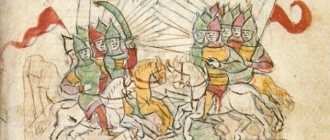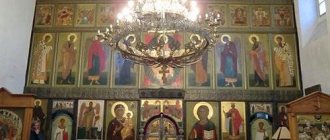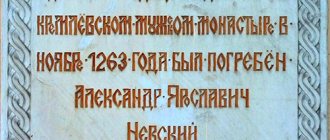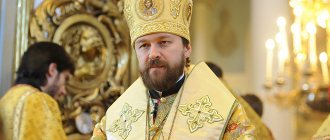Among the biblical characters, Jewish women are mentioned who took the lives of sleeping men for the good of their people. The story of Judith is widely known, cutting off the head of the Assyrian commander Holofren, who was besieging her hometown of Vestilue, in her sleep.
There is a mention of Jael driving a stake into the head of the sleepy Canaanite general Sisera, who was hiding after defeat in the war with the Jews. On Slavic soil there was a similar story. A noble woman tried to kill the sleepy prince - her husband, avenging a blood grudge. This woman's name is Rogneda.
Biography
The future princess of Kievan Rus was born two days before the death of her father, the Byzantine Emperor Roman II, thanks to which the exact date of her birth became known.
Her mother Feofano was born into a simple family of a tavern owner, of Armenian origin, and was distinguished by an amazing combination of divine beauty, extraordinary intelligence and depravity. Thanks to these qualities, she managed not only to win the heart of the heir to the Byzantine throne, Roman, but also to gain the trust of Emperor Constantine VII and his wife, Empress Helena.
Queen Feofano - Anna's mother
After the death of Constantine VII, Theophano forced her husband to hide five of her sisters in a monastery, and soon she brought Elena to the grave with her intrigues.
Emperor Roman II, Anna's father, was distinguished by his pleasant appearance, education, and also a penchant for horse racing and excessive carnal pleasures. What exactly killed him is not known for certain, but, having been on the throne for only four years, he unexpectedly died at the age of 24. There were even rumors that the emperor was poisoned.
Emperor Roman II - Anna's father
Feofano managed to give birth to her husband four children, the last of them, Anna, was born two days before his death.
Childhood
After the death of Emperor Roman, as a result of palace intrigues, the commander Nikephoros II Phocas took possession of the throne, having married Theophano. Thus, Anna's mother, who became regent over her sons, tried to protect herself and her children from the attacks of the insidious nobility. But six years later, she again organized a conspiracy, this time against Nicephorus, with the help of her next lover, John Tzimiskes, an associate of her gullible husband. The emperor was treacherously killed in his bed, and Tzimiskes became the new ruler. However, he did not marry Feofano, but treacherously sent her to a remote island lost in the Aegean Sea. Young Anna also went there with her mother.
Coronation of John Tzimisces
While in exile, the young princess became interested in studying the rich heritage of her paternal ancestors. Her grandfather, Emperor Constantine VII, left to his descendants a huge number of works on medicine, history and other sciences. She carefully studied his descriptions of the lives of saints, illustrated with artistic miniatures of amazing beauty and grace. From the chronicles, Anna learned that her grandfather was not alien to the interests of the common people. During his reign, he built hospitals and shelters for the needy, organized the distribution of alms, took an interest in the fate of the convicted, and suppressed the abuses of officials.
Anna also studied the treatises of her great-great-grandfather Vasily I, intended for his son Emperor Leo I the Wise, from which she also learned a lot of interesting and useful things.
Anna of Byzantium
After the death of Tzimiskes in 976, power passed to Theophano’s sons Vasily and Constantine, who allowed Anna and her mother to return to the palace, however, the empress was not allowed to take power and wanted to rule themselves. Their reign was remembered for incessant wars and rebellions. In addition to the strife within the country, Constantinople itself was faced with an external threat. The Russian prince Vladimir Svyatoslavovich threatened to take possession of the Byzantine capital, and the forces of the emperors were running out. As a result, the brothers promised to give him Princess Anna as his wife, provided that Vladimir would provide them with military assistance and accept Christianity.
Anna by that time had turned into an enviable bride and a real beauty; her hand was sought by the heir of the Roman Empire, the son of the French king and the Bulgarian prince. Marriage to a foreigner and barbarian was an unheard-of humiliation for a girl, but the brothers managed to persuade her.
Vladimir's Fury
Enraged by the refusal of his chosen one, Vladimir set off with his army to Polotsk. A huge squad, consisting of Novgorodians, Chuds, Krivichi and Varangians, found themselves under the walls of the city. Rogvolod opposed Vladimir, but was defeated, and in 978 Polotsk fell under the pressure of the princely army.
However, Vladimir did not want to calm down. On the instructions of his uncle, he humiliated the entire Rogneda family. He violated his brother's fiancee in front of her relatives, after which Rogvolod, his wife and sons were killed.
Subsequently, the unbridled prince sent his squad to Kyiv. Yaropolk was killed, and his unfortunate bride became Vladimir's second wife. Rogneda was settled in a small village on Lybid. Vladimir visited her periodically, and on one of these visits an incident occurred, described by the chroniclers.
Alisa Skachkova “The Abduction of Rogneda by Prince Vladimir”
One night Rogneda decided to stab the sleeping prince. For many years she hated this man, and now she had a chance to get even with him. But, to her great regret, Vladimir woke up and managed to deflect the blow.
What do you think could await a woman after such an act? Of course, the death penalty, and the prince decided to personally punish his wife. So that the reprisal against the criminal would not seem like an ordinary murder, he ordered Rogneda to put on a ritual (wedding) outfit.
When Vladimir had already raised his sword to strike, his son Izyaslav suddenly ran into the room, blocking his mother. Not knowing what to do, the prince asked the boyars for advice. The Tale of Bygone Years quotes them as saying:
“Do not kill her for the sake of this child, but build up her father’s fatherland and give it to her with your son.”
Izyaslav protects his mother / Cover of the book “Women of the House of Rurikovich”
Wedding
A wedding flotilla of three ships was sent to Korsun (now Chersonesus in the territory of modern Sevastopol). On board, in addition to Anna, there were priests who were supposed to perform the baptismal ceremony. Prince Vladimir personally met the bride and was amazed by her beauty. The groom, in turn, also made a pleasant impression on the princess.
Arrival of Anna of Byzantium
In the main temple of Korsun, Byzantine priests baptized the Grand Duke and gave him a new name, Vasily, in honor of one of the bride’s brothers. There is a legend that Vladimir, who had previously suffered from an eye disease and could see almost nothing, immediately after the baptismal ceremony received his sight and, inspired by God’s grace, ordered his squad and the boyars accompanying him to be baptized immediately.
Baptism of Vladimir Svyatoslavovich
The wedding of 33-year-old Vladimir and 25-year-old Anna also took place there. The prince ordered all the gifts sent to be returned to the bride's brothers and he himself gave them the previously conquered Korsun as a ransom according to Russian custom. This marriage helped Prince Vladimir gain independence from Constantinople and unlimited power over the Russian Church.
Polotsk beauty
Rogneda was born approximately in 960 (historians do not have more precise data) in Polotsk. Her father was the local ruler Rogvolod, about whom the Tale of Bygone Years says this:
“This Rogvolod came from across the sea and held his power in Polotsk.”
According to researchers, the “overseas” origin of the prince may be connected with his foreign, and more specifically, Varangian roots. Rogneda could actually be called by the Scandinavian name Ragnhild. However, there is a version that the girl’s name could be of Slavic origin and mean “pampered by power.”
From an early age, the princess realized her importance. In addition, residents and guests of Polotsk praised its beauty. When the time came to look for a husband for the girl, she knew that she would choose the most worthy as her husband. Vladimir Svyatoslavich, who ruled Novgorod at that time, wooed her, but received a decisive refusal. “I don’t want rozuti robichich,” said the proud princess.
This meant the custom of taking off a spouse’s shoes, but she calls Vladimir “robichich” for a reason. This word meant “son of a slave,” that is, Rogneda knew about the prince’s origins and questioned his nobility. Yaropolk Svyatoslavich, Vladimir’s brother, was eventually announced as the princess’s groom.
Anton Losenko “Vladimir and Rogneda” / State Russian Museum, St. Petersburg
Merits
Returning with his young wife to Kyiv, Vladimir immediately baptized his sons in the spring, which later received the name Khreshchatyk. On August 1, the prince baptized the people of Kiev, calling all the inhabitants of the city to the banks of the Dnieper, and ordered the destruction of all pagan symbols.
Having converted to the Christian faith, Prince Vladimir renounced all his numerous previous wives and concubines and proclaimed Anna the only wife given to him by God.
Church of the Blessed Virgin Mary in Kyiv
Having become the Grand Duchess of Kyiv, Anna began to spread Christianity and build churches in Rus'. The first temple she founded was the Church of the Blessed Virgin Mary in Kyiv (Church of the Tithes), created in the image and likeness of her beloved Pharos Church of Anna in Constantinople. She brought into fashion elements of stained glass, which Byzantine masters used to decorate churches.
Thanks to her, the annual magnificent celebration of the Dormition of the Blessed Virgin Mary was introduced into church life. On the recommendation of his wife, Prince Vladimir purchased a monastery for Russian Orthodox monks on Mount Athos.
Church Charter "Nomocanon"
Anna did not forget about educational activities, guided by the legacy of her great ancestors. The Greek church charter “Nomocanon” brought by her was laid as the basis of the Russian Church, and icons and church utensils became a model for copying by Russian icon painters and artisans. She created special educational institutions to train local clergy.
Thanks to Anna, Vladimir’s sons became imbued with the spirit of Christianity and began to actively introduce it among their subjects. Even the ex-wife of Prince Rogneda became a zealous Christian and founded the first convent in Rus', taking monastic vows there.
Death
Did Anna have children from Prince Vladimir? Historians are still arguing about this topic. According to one of the existing versions, the princess gave birth to her wife, sons Boris and Gleb. Of all the twelve sons of the prince from different wives, these were the most beloved. Their life was tragic. Vladimir predicted a great future for his sons, and dreamed of placing Boris on the Bulgarian throne.
But fate decreed otherwise, and the eldest unloved son of the prince, Svyatopolk, was to blame. People called him “the son of two fathers,” so Vladimir inherited his mother, already pregnant, from his brother Yaropolk, who was also killed by him. It so happened that it was Svyatopolk who found himself next to his father in the last minutes of his life. Historians still doubt his innocence in his father’s death.
Sarcophagus of Anna of Byzantium
However, the people of Kiev opposed his ascension to the throne and began to demand Boris to rule. Then Svyatopolk decided to get rid of his half-brothers and sent assassins to them. For this, the people nicknamed him Svyatopolk the Accursed, and in honor of the Great Martyrs Boris and Gleb, a church was built in Vyshgorod in 1021.
Anna did not live to see these tragic events. She died four years earlier at the age of 48. Vladimir ordered a marble sarcophagus made by the best Byzantine craftsmen and placed it in the Church of the Blessed Virgin Mary. Later, his sarcophagus took pride of place next to his beloved wife.
Interesting facts from the life of Rogneda
- Rogneda was raped in front of her parents on the advice of her mentor Vladimir, her mother’s brother Dobrynya. Thus, Dobrynya took revenge for his wounded pride during matchmaking. He could not forgive the mention of the slave status of his sister and mother of Vladimir.
- Rogneda-Gorislava had a great influence on the formation of the worldview of her son Yaroslav. The fate of the mother was reflected in the Charter (Law) of Prince Yaroslav, popularly nicknamed “The Wise”. The charter prohibited not only the forcible marriage of girls, but also the obstruction of their desire to enter into love marriages.
Movies
At the end of 2016, the large-scale film “Viking” was released on Russian screens, the central character of which was Prince Vladimir, performed by Danila Kozlovsky. The film is based on real historical events and tells about the bloody struggle of three brothers Vladimir, Oleg and Yaropolk, who despised family ties and were forced to turn weapons against each other. Work on the painting lasted about six years. The unique combination of the latest computer technology and masterful acting turned this film into the main cinematic event of the year.
The film features a whole constellation of popular Russian actors: Kirill Pletnev, Svetlana Khodchenkova, Igor Petrenko, Andrey Smolyakov, Maxim Sukhanov and many others. To achieve a perfect resemblance to historical characters, costumes, jewelry and weapons were made by hand. To do this, costume designers and prop designers used authentic descriptions of the characters' appearances, taken from historical sources. Unfortunately, the authors undeservedly ignored Princess Anna in this film.
Another high-profile premiere is expected in 2022, this time entirely dedicated to the life of this great woman. A 12-episode film “Anna of Byzantium” will be released. This is a new project by Star Media, which is the result of joint activities with American colleagues. An English version of the series is also planned.
In Polotsk
The childhood of the young princess took place in ancient Polotsk. In historical literature there is a mention that Rogneda’s father, Prince Rogvolod of Polotsk, had roots of Scandinavian (Varangian) origin. An indirect confirmation of this fact are the Old Scandinavian names: male - “Ragnvald” (from the word “regin” - higher power, gods) and female “Regnhild”. On Slavic soil the words were transformed into Rogvolod and Rogneda.
In addition to the girl, two brothers grew up in the family. By the age of 16, the girl blossomed. The fame of the Polotsk woman’s beauty and intelligence spread far beyond the borders of the principality. In modern language, we can say that in Polotsk there were more democratic orders than in the surrounding lands. A woman was not a thing without rights.
She was treated with respect, her opinion was taken into account. Subsequently, this circumstance played a fatal role in the life of the princess. Many well-born grooms dreamed of seeing an intelligent and beautiful girl as their wife.
The legend of Prince Vladimir's matchmaking with Polotsk woman Rogneda











